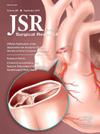基于机器学习算法的肿瘤-间质比可对肝内胆管癌的预后进行分层
IF 1.7
3区 医学
Q2 SURGERY
引用次数: 0
摘要
本研究旨在通过机器学习算法量化肿瘤成分,探索有效的生物标志物,对肝内胆管癌(iCCA)根治性手术后的预后进行分层。方法选取经根治性手术治疗的iCCA患者237例。构建半自动化流水线,测量肿瘤微环境成分,包括肿瘤、淋巴细胞、基质细胞,计算肿瘤-基质比、肿瘤浸润淋巴细胞比%。比较总生存期(OS)和无病生存期(DFS)以评估其预后价值。然后探讨辅助化疗的预测价值。结果Kaplan-Meier分析显示,高基质和低肿瘤浸润淋巴细胞比例%与较短的DFS和OS相关,多变量Cox分析也验证了iCCA的预后价值,包括DFS(风险比:1.59,95%可信区间:1.10 ~ 2.30,P = 0.015)和OS(风险比:1.92,95%可信区间:1.27 ~ 4.17,P < 0.001)。与之前的分期系统相比,包括第8届美国癌症联合委员会系统和日本肝癌研究小组系统,nomogram表现出更好的疗效。低基质组更有可能从化疗中获益,包括DFS和OS (P = 0.019和P = 0.002)。结论基于机器学习的肿瘤-基质比可作为iCCA根治性术后有效的预后生物标志物,并有预测辅助化疗疗效的潜力。本文章由计算机程序翻译,如有差异,请以英文原文为准。
Machine Learning Algorithm-Based Tumor-Stroma Ratio Can Stratify the Prognosis of Intrahepatic Cholangiocarcinoma
Introduction
The study aimed to quantify tumor components through the machine learning algorithm and explore effective biomarkers to stratify the prognosis of intrahepatic cholangiocarcinoma (iCCA) after radical surgery.
Methods
A cohort of 237 iCCA patients who underwent radical resection was recruited. The semiautomated pipeline was constructed to measure the tumor microenvironment components, including tumor, lymphocyte, and stromal cells, tumor-stroma ratio, and tumor-infiltrated lymphocytes ratio % were calculated. The overall survival (OS) and disease-free survival (DFS) were compared to evaluate their prognostic values. The predictive values for adjuvant chemotherapy were then explored.
Results
The Kaplan–Meier analysis showed that high-stroma and low-tumor-infiltrated lymphocytes ratio % were associated with shorter DFS and OS, and the multivariable Cox analysis also verified the prognosis values of iCCA including DFS (hazard ratio: 1.59, 95% confidence interval: 1.10-2.30, P = 0.015) and OS (hazard ratio: 1.92, 95% confidence interval: 1.27-4.17, P < 0.001). The nomograms presented better performance than previous staging systems, including the 8th American Joint Committee on Cancer system and the Liver Cancer Study Group of Japan system. The low-stroma cohort was more likely to benefit from chemotherapy, including DFS and OS (P = 0.019 and P = 0.002).
Conclusions
Machine learning–based tumor-stroma ratio could serve as an effective prognostic biomarker for iCCA after radical surgery and potentially predict the therapeutic response of adjuvant chemotherapy.
求助全文
通过发布文献求助,成功后即可免费获取论文全文。
去求助
来源期刊
CiteScore
3.90
自引率
4.50%
发文量
627
审稿时长
138 days
期刊介绍:
The Journal of Surgical Research: Clinical and Laboratory Investigation publishes original articles concerned with clinical and laboratory investigations relevant to surgical practice and teaching. The journal emphasizes reports of clinical investigations or fundamental research bearing directly on surgical management that will be of general interest to a broad range of surgeons and surgical researchers. The articles presented need not have been the products of surgeons or of surgical laboratories.
The Journal of Surgical Research also features review articles and special articles relating to educational, research, or social issues of interest to the academic surgical community.

 求助内容:
求助内容: 应助结果提醒方式:
应助结果提醒方式:


